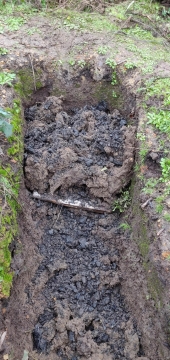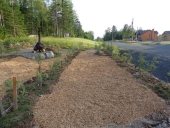posted 1 year ago
So much depends on the exact ecosystem and soil type.
I have actually suggested that a friend try a version of this on his heavy clay soil, in an effort to introduce carbon into the soil between existing mature fruit trees. My friend thinks he may have a layer of hard pan or plow pan which is interfering with water infiltration. It's very hard to know. I would think that with mature full size fruit trees, their roots would have broken up any hard layer, but I'm not about to dig up his yard to find out!
I have read that if you put wood vertically, and it isn't covered, there's a chance it will wick water out of the hugel bed. This is not something that would be easy to prove and the one spot I did that in an effort to stop a compost/hugel mound from collapsing onto a path, I would say that I couldn't tell if that was an effect or not. In my ecosystem, there are plenty of stumps left by former tree cutters, and again, I wouldn't say they dry things out more than the normal summer drought, and Huckleberries certainly like to germinate, grow and produce on some stumps.
I've also read about the concept of digging a hole and filling it with all sorts of compostable material in an effort to improve soil. The suggestion as I remember it, is 1 foot diameter by 3 feet deep. In my rocky clay soil, that's just not happening! However, I have done a number of holes like this, particularly near fruit trees, with mixed success. I do think the holes help with water infiltration, but I can't "prove" it. I'm lucky if I manage a foot deep and 2 feet diameter, often larger diameter, because every time I hit a rock, things get wider in order to get the rock out. I grow rocks really well!
One thing to keep in mind is that if wood dries out, and then you get a lot of rain, it floats. There has been a situation where someone buried wood in the dirt from a swale, and the whole thing slid down the hill when there was a big rainstorm after a long drought. I have buried lots of wood on my land, and I've not personally observed this effect, but I'm working at a much smaller scale than the example I heard about. What you're describing doing, seems to me to be that smaller scale and soil friction against the wood would keep it in place.
I look forward to hearing how this all works out when you find a place to try it.

 1
1




 3
3




 1
1




 1
1




 1
1




 3
3




 1
1









